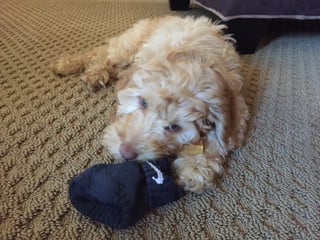 I recently got a puppy and we’ve been diligently training him to handle all the obvious commands. First and most important, he needs to do his business outside. Next we want him to be controlled so walking next to us on the leash, stay when directed, come when requested and down if necessary. Just the basics, after all, he’s just a puppy. We can’t expect him to do everything on day one.
I recently got a puppy and we’ve been diligently training him to handle all the obvious commands. First and most important, he needs to do his business outside. Next we want him to be controlled so walking next to us on the leash, stay when directed, come when requested and down if necessary. Just the basics, after all, he’s just a puppy. We can’t expect him to do everything on day one.
That got me thinking about how we train new inbound marketing agency team members and how similar some of the experiences probably should be, yet how different they are in reality. I’ll preface this by saying I think we could be much better at training new team members. I think in general it’s a lot of, “your smart, figure it out.” I’m pretty sure that’s not the right approach.
Here are a few techniques to consider when you’re getting new inbound agency team members up to speed.
Role Play
One of the best ways to train up your new inbound agency team members is to do role play. We actually still do a fair amount of this at our place. I actually like doing this, so I’ll share a situation or a condition with our team and then I’ll role play how I would help a client, guide a client or work out a situation that might be a little sticky.
Then I’ll ask a few of the participants to do the same and I’ll give them guidance and suggestions on how to manage the situation more productively. For instance, I constantly talk about giving clients options. Here are three ways to handle your situation, which would you like to move forward with. While we support them all, we think Option B is best for you.
Another is consequences. This comes up a lot. “I understand you can’t get the website copy back to us like we agreed you would and that means your site will be delayed a week, so I need to adjust the visitors traffic, conversion and lead goal projections because we thought the site would be up by the beginning of the month. Oh, you CAN get us the copy back by the end of the day, great…now I won’t have to make any adjustments to the projections, thank you!”
Clients need to know that their actions have reactions that impact their programs and your people need to know how to communicate that in a productive way.
Behind The Scenes
Sometimes doing the work is easier than managing the client. So what we do is have the new team members working behind the scenes while the current team (who the client knows and trusts) handles the client. Over time we introduce the new team member to the client and actively transition the relationship. As the client becomes more comfortable, the existing team member transitions to the back and the relationship continues.
This approach allows us to meter the amount of work and monitor their progress. We only introduce them to the client when we see they’re going to make it, when we see they’re strong enough to manage the work and the client relationship and when we think the client is ready to work with our new team member. This training approach works almost every time.
Show and Do, Not Tell and Do
Most people want to tell new team members what to do and then expect them to know. But inbound is such a hands on practice I think showing is better than telling. So instead of telling someone what you want them to do, show them. This might actually require you doing it and them watching a couple of times before they know exactly how you want something done.
People have different learning styles. You want to find the one that works for your new team member, not the style that works for you.
Setting Clear Goals
Finally, setting clear goals are good for everyone. You and your people agree upfront how much progress needs to be made and by when. Then communicate that to your new team member. Set up the gates and the goals so everyone is clear.
For instance, by the end of 60 days you need to be running solo on at least one client account is a clear goal that everyone can understand. We typically set these goals at the 30, 60 and 90 day marks for new team members. This gives us the opportunity to work with them for shorter periods of time and see how they’re doing. This also allows us to give them a formal review every 30 days during their initial 90-day stay with us.
A lot of people, even at our place, set overly aggressive goals for the first 30 days, so most people find they need to rally in the next 30 days to catch up and be where they need to be. If our overall plan is too aggressive, the 30-day check in gives us a chance to reset the goals and come up with a more reasonable plan.
Formalize The Training
If you’re planning on growing your agency, then you need to formalize all these processes. Growth means adding new team members at a regular clip and if you can’t operationalize the training and onboarding growing is going to be very problematic.
Make sure someone is responsible for your new team member. At Square 2 Marketing everyone has a leader but they also have a mentor. The leader is responsible and accountable for getting the team member trained, functional, efficient and effective but the mentor is responsible for helping the new team member get acclimated to our culture, Core Values and our company. This combination works very well.
Like almost everything you do, most of what you start doing won’t be what you finish with. You’ll make some mistakes but the goal is to recover from those mistakes quickly, makes sure you don’t make them again and change what you’re doing to deliver a better experience for your new team member.
 Start Today Tip – If you can’t document your onboarding and training, you’re not ready to do it. Like most of the agency operations you need a playbook for training and onboarding and you probably need a playbook by role. This is something you could work on today. Create the entire experience from the time new team members say yes, to the time you trust them with your clients. Make sure that experience is remarkable, documented, communicated to the team and bullet proof (meaning everyone knows exactly what to do and when). Now you’re ready to hire. Now you’re ready to hire people who will be great for you and for your clients.
Start Today Tip – If you can’t document your onboarding and training, you’re not ready to do it. Like most of the agency operations you need a playbook for training and onboarding and you probably need a playbook by role. This is something you could work on today. Create the entire experience from the time new team members say yes, to the time you trust them with your clients. Make sure that experience is remarkable, documented, communicated to the team and bullet proof (meaning everyone knows exactly what to do and when). Now you’re ready to hire. Now you’re ready to hire people who will be great for you and for your clients.
Agencies 2 Inbound – Helping Agencies Go ALL IN ON Inbound!

